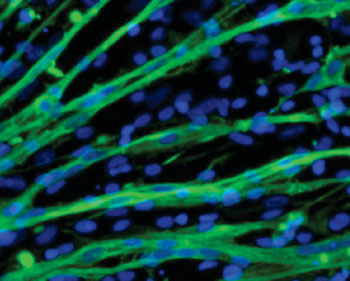Novel Culture Technique Generates Large Numbers of Functional Human Muscle Cells
By LabMedica International staff writers
Posted on 31 Mar 2014
A novel technique that uses free-floating spherical culture (EZ spheres) in a defined, serum-free culture medium generated large numbers of functional muscle cells from human embryonic stem (hES) and induced pluripotent stem (iPS) cells.Posted on 31 Mar 2014
Investigators at the University of Wisconsin (Madison, USA) used the EZ sphere procedure to transform hES and iPS cells into myogenic progenitors by growing the cells in serum-free medium that was supplemented with high concentrations of fibroblast growth factor-2 (FGF-2) and epidermal growth factor (EGF).

Image: Muscle cells are stained green in this micrograph of cells grown from embryonic stem cells. Cell nuclei are stained blue; the muscle fibers contain multiple nuclei. Nuclei outside the green fibers are from non-muscle cells (Photo courtesy of Dr. Masatoshi Suzuki, University of Wisconsin).
They reported in the March 21, 2014, online edition of the journal Stem Cells Translational Medicine that under these culture conditions myogenic progenitors were detectable in the spheres after six weeks of culture and multinucleated myotubes following sphere dissociation and two weeks of terminal differentiation. A high concentration of FGF-2 played a critical role for myogenic differentiation and was necessary for generating myogenic progenitors from pluripotent cells cultured as EZ spheres.
Approximate 40% to 60% of the cells grown using this process matured into either muscle cells or muscle progenitors, a high proportion compared to traditional nongenetic techniques of generating muscle cells from human ES and iPS cells. Furthermore, EZ sphere culture was capable of producing myogenic progenitors from human iPS cells generated from both healthy donors and patients with neuromuscular disorders (including Becker’s muscular dystrophy, spinal muscular atrophy, and familial amyotrophic lateral sclerosis).
"Researchers have been looking for an easy way to efficiently differentiate stem cells into muscle cells that would be allowable in the clinic," said senior author Dr. Masatoshi Suzuki, assistant professor of comparative biosciences at the University of Wisconsin. "The novelty of this technique is that it generates a larger number of muscle stem cells without using genetic modification, which is required by existing methods for making muscle cells. Our protocol can work in multiple ways and so we hope to provide a resource for people who are exploring specific neuromuscular diseases in the laboratory."
Related Links:
University of Wisconsin













